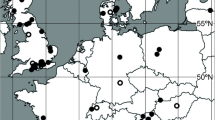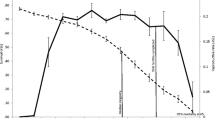Abstract
The ageing theory predicts fast and early senescence for fast-living species. We investigated whether the pattern of senescence of a medium-sized, fast-living and heavily-culled mammal, the red fox (Vulpes vulpes), fits this theoretical prediction. We used cross-sectional data from a large-scale culling experiment of red fox conducted over six years in five study sites located in two regions of France to explore the age-related variation in reproductive output. We used both placental scars and embryos counts from 755 vixens’ carcasses aged by the tooth cementum method (age range: 1–10), as proxies for litter size. Mean litter size per vixen was 4.7 ± 1.4. Results from Generalized Additive Mixed Models revealed a significant variation of litter size with age. Litter size peaked at age 4 with 5.0 ± 0.2 placental scars and decreased thereafter by 0.5 cubs per year. Interestingly, we found a different age-specific variation when counting embryos which reached a plateau at age 5–6 (5.5 ±0.2) and decreased slower than placental scars across older ages, pointing out embryo resorption as a potential physiological mechanism of reproductive senescence in the red fox. Contrary to our expectation, reproductive senescence is weak, occurs late in life and takes place at an age reached by less than 11.7% of the population such that very few females exhibit senescence in these heavily culled populations.
Similar content being viewed by others
References
Artois, M., Aubert, M.F.A., Gerard, Y., 1982. Reproduction du renard roux (Vulpes vulpes) en France: rythme saisonnier et fécondité des femelles. Acta Oecol. 3, 205–216.
Austad, S.N., 1993. Retarded senescence in an insular population of Virginia opossums (Didelphis virginiana). J. Zool. 229, 695–708.
Beehner, J.C., 2006. The ecology of conception and pregnancy failure in wild baboons. Behav. Ecol. 17, 741–750.
Berger, V., Lemaitre, J.F., Dupont, P., Allainé, D., Gaillard, J.M., Cohas, A., 2016. Age-specific survival in the socially monogamous alpines marmot (Marmota marmota): evidence of senescence. J. Mammal. 97, 992–1001.
Bielby, J., Mace, G.M., Bininda-Emonds, O.R., Cardillo, M., Gittleman, J.L. Jones, K.E., Orme, C.D., Purvis, A., 2007. The fast-slow continuum in mammalian life history: an empirical reevaluation. Am. Nat. 169, 748–757.
Borg, K., 1970. On mortality and reproduction of roe deer in Sweden during the period 1948-69. Viltrevy 7, 119–149.
Bouwhuis, S., Charmantier, A., Verhulst, S., Sheldon, B.C., 2010. Individual variation in rates of senescence: natal origin effects and disposable soma in a wild bird population. J. Anim. Ecol. 79, 1251–1261.
Broussard, D.R., Risch, T.S., Dobson, F.S., Murie, J.O., 2003. Senescence and age-related reproduction of female Columbian ground squirrels. J. Anim. Ecol. 72, 212–219.
Burnham, K.P., Anderson, D.R., 2002. Model Selection and Multimodel Inference: A Practical Information-theoric Approach, 2nd ed. Springer Verlag, New York, USA.
Cavallini, P., Santini, S., 1996. Reproduction of the red fox Vulpes vulpes in Central Italy. Ann. Zool. Fenn. 33, 267–274.
Cody, M.L., 1966. A general theory of clutch size. Evolution 20, 174–184.
Cole, L.C., 1954. The population consequences of life history phenomena. Quart. Rev. Biol. 29, 103–137.
Costello, C.M., Inman, K.H., Jones, D.E., Inman, R.M., Thompson, B.C., Quigley, H.B., 2004. Reliability of the cementum annuli technique for estimating age of black bears in New Mexico. Wildl. Soc. B32, 169–176.
Cross, J.C, Werb, Z., Fisher, S.J., 1994. Implantation and the placenta: key pieces of the developmental puzzle. Science 266, 1508–1518.
Devenish-Nelson, E.S., Stephens, P.A., Harris, S., Soulsbury, C., Richards, S.A., 2013a. Does litter size variation affect models of terrestrial carnivore extinction risk and management? PLoS One 8 (2), e58060.
Devenish-Nelson, E.S., Harris, S., Soulsbury, C.D., Richards, S.A., Stephens, P.A., 2013b. Demography of a carnivore, the red fox, Vulpes vulpes: what have we learnt from 70 years of published studies? Oikos 122, 705–716.
Dobzhansky, T., 1950. Evolution in the tropics. Am. Sci. 38, 208–221.
Dugdale, H.L., Pope, L.C., Newman, C., Macdonald, D.W., Burke, T., 2011. Age-specific breeding success in a wild mammalian population: selection, constraint, restraint and senescence. Mol. Ecol. 20, 3261–3274.
Elmeros, M., Pedersen, V., Wincentz, T.L., 2003. Placental scar counts and litter size estimations in ranched red foxes (Vulpes vulpes). Mamm. Biol. 68, 391–393.
Englund, J., 1970. Some aspects of reproduction and mortality rates in Swedish foxes (Vulpes vulpes), 1961-63 and 1966-69. Sweden Wildl. 8, 1–82.
Ericsson, G., Wallin, K., Ball, J.P., Broberg, M., 2001. Age-related reproductive effort and senescence in free-ranging moose, Alces alces. Ecology 82, 1613–1620.
Finn, C.A., 1977. The implantation reaction. In: Wynn, R.M. (Ed.), Biology of the Uterus. Plenum Press, New York, pp. 245–308.
Gaillard, J.-M., Pontier, D., Allainé, D., Lebreton, J.D., Trouvilliez, J., Clobert, J., 1989. An analysis of demographic tactics in bird and mammals. Oikos 56, 59–76.
Gaillard, J.M., Allaine, D., Pontier, D., 1994. Senescence in natural populations of mammals: a reanalysis. Evolution 48, 509–516.
Gaillard, J.M., Lemaître, J.F., Berger, V., Bonenfant, C., Devillard, S., Douhard, M., Gamelon, M., Plard, F., Lebreton, J.D., 2016. Life histories, axes of variation. In: Kliman, R.M. (Ed.), Encyclopedia of Evolutionary. Biology, vol. 2. Academic Press, Oxford, pp. 312–323.
Gittleman, J.L., 1986. Carnivore life history patterns Allometric, phylogenetic, and ecological associations. Am. Nat. 127, 744–771.
Grau, G.A., Sanderson, G.C, Rogers, J.P., 1970. Age determination of raccoons. J. Wildl. Manag. 34, 364–371.
Hanks, J., 1972. Reproduction of elephant, Loxodonta africana, in the luangwa valley, Zambia. J. Reprod. Fertil. 30, 13–26.
Harris, S., Smith, G.C., 1987. Demography of two urban fox (Vulpes vulpes) populations. J. Appl. Ecol. 24, 75–86.
Harris, S., Cresswell, W.J., Cheeseman, C.L., 1992. Age determination of badgers (Meles meles) from tooth wear: the need for a pragmatic approach. Comm. Mamm. Soc. 65, 679–684.
Harris, S., 1978. Age determination in the red fox (Vulpes vulpes) - an evaluation of technique efficiency as applied to as sample of suburban fixes. J. Zool. 184, 91–117.
Harris, S., 1979. Age-related fertility and productivity in red foxes, Vulpes vulpes, in suburban London. J. Zool. 187, 195–199.
Harvey, P.H., Clutton-Brock, T.H., 1985. Life history variation in Primates. Evolution 39, 559–581.
Hewison, A.J.M., Gaillard, J.M., 2001. Phenotypic quality and senescence affect different components of reproductive output in roe deer. J. Anim. Ecol. 70, 600–608.
Heydon, M.J., Reynolds, J.C., 2000. Demography of rural foxes (Vulpes vulpes) in relation to cull intensity in three contrasting regions of Britain. J. Zool. 251, 265–276.
Jones, O.R., Gaillard, J.M., Tuljapurkar, S., Alho, J.S., Armitage, K.B., Becker, P.H., Bize, P., Brommer, J., Charmantier, A., Charpentier, M., Clutton-Brock, T., Dobson, F.S., Festa-Bianchet, M., Gustafsson, L., Jensen, H., Jones, C.G., Lillandt, B.G., McCleery, R., Merilä, J., Neuhaus, P., Nicoll, M.A.C., Norris, K., Oli, M.K., Pemberton, J., Pietiäinen, H., Ringsby, T.H., Roulin, A., Saether, B.E., Setchell, J.M., Sheldon, B.C., Thompson, P.M., Weimerskirch, H., Wickings, J.E., Coulson, T., 2008. Senescence rates are determined by ranking on the fast-slow life-history continuum. Ecol. Lett. 11, 664–673.
King, C.M., 1991. A review of age determination methods forthe stoat Mustela erminea. Mamm. Rev. 2, 31–49.
Kirkwood, T.B.L., Austad, S.N., 2000. Why do we age? Nature 408, 233–238.
Kirkwood, T.B.L., Rose, M.R., 1991. Evolution of senescence: late survival sacrificed for reproduction. Phil. Trans. Royal Soc. London B: Biol. Sci. 332, 15–24.
Kirkwood, T.B.L., 1977. Evolution of ageing. Nature 270, 301–304.
Lack, D., 1947. The significance of clutch size. Ibis 89, 302–352.
Lemaître, J.F., Berger, V., Bonenfant, C., Douhard, M., Gamelon, M., Plard, F., Gaillard, J.M., 2015. Early-late life trade-offs and the evolution of ageing in the wild. Proc. R. Soc. Lond. B: Biol. Sci. 282, 02–09.
Lieury, N., Ruette, S., Devillard, S., Drouyer, F., Baudoux, B., Millon, A., 2015. Compensatory immigration challenges predator control: an experimental evidence-based approach improves management. J. Wildl. Manag. 79, 425–434.
Lindström, E.R., 1989. Food limitation and social regulation in a red fox population. Ecography 12, 70–79.
Lindström, E.R., 1994. Placental scar in the red fox (Vulpes vulpes L.) revisited. Z. Saugetierkd. 59, 169–173.
Marlow, N.J., Thomson, P.C., Algar, D., Rose, K., Kok, N.E., Sinagra, J.A., 2000. Demographic characteristics and social organisation of a population of red foxes in a rangeland area in Western Australia. Wildl. Res. 27, 457–464.
Massot, M., Clobert, J., Montes-Poloni, L., Haussy, C., Cubo, J., Meylan, S., 2011. An integrative study of ageing in a wild population of common lizards. Funct. Ecol. 25, 848–858.
Matson, G.M., Matson, J., 1993. Progress inCementum Aging of Martens and Fishers. Special Report No. 931. Matson’s Laboratory Ed., Milltown, MT.
McDonald, T.L., White, G.C, 2010. A comparison of regression models for small counts. J. Wildl. Manag. 74, 514–521.
McIlroy, J., Saunders, G., Hinds, L.A., 2001. The reproductive performance of female red foxes, Vulpes vulpes, in central-western New South Wales during and after a drought. Can. J. Zool. 79, 545–553.
Melero, Y., Robinson, E., Lambin, X., 2015. Density- and age-dependent reproduction partially compensates culling efforts of invasive non-native American mink. Biol. Invas. 17, 2645–2657.
Nussey, D.H., Kruuk, L.E.B., Donald, A., Fowlie, M., Clutton-Brock, T.H., 2006. The rate of senescence in maternal performance increases with early-life fecundity in red deer. Ecol. Lett. 9, 1342–1350.
Nussey, D.H., Coulson, T., Festa-Bianchet, M., Gaillard, J.M., 2008. Measuring senescence in wild animal populations: towards a longitudinal approach. Funct. Ecol. 22, 393–406.
Nussey, D.H., Froy, H., Lemaitre, J.-F., Gaillard, J.M., Austad, S.N., 2013. Senescence in natural populations of animals: widespread evidence and its implications for bio-gerontology. Ageing Res. Rev. 12, 214–225.
Packer, C., Herbst, L., Pusey, A.E., Bygott, J.D., Hanby, J.P., Cairns, S.J., Borgerhoff Mulder, M., 1988. Reproductive success of lions. In: Clutton-Brock, T.H. (Ed.), Reproductive Success: Studies of Individual Variation in Contrasting Breeding Systems. University of Chicago Press, Chicago, pp. 363–383.
Promislow, D.E.L., 1991. Senescence in natural populations of mammals: a comparative study. Evolution 45, 1869–1887.
R Development Core Team, 2012. R: A Language and Environment for Statistical Computing. R Foundation for Statistical Computing, Vienna, Austria, ISBN 3-900051-07-0.
Read, A.F., Harvey, P.H., 1989. Life history differences among the eutherian radiations. J. Zool. 219, 329–353.
Reid, J.M., Bignal, E.M., Bignal, S., McCracken, D.I., Monaghan, P., 2003. Age-specific reproductive performance in red-billed choughs Pyrrhocorax pyrrhocorax: patterns and processes in a natural population. J. Anim. Ecol. 72, 765–776.
Ruette, S., Albaret, M., 2011. Reproduction of the red fox Vulpes vulpes in western France: does staining improve estimation of litter size from placental scar counts? Eur. J. Wildl. Res. 57, 555–564.
Schwartz, C.C., Keating, K.A., Reynolds, H.V., Barnes, V.G., Sellers, R.A., Swenson, J.E., Miller, S.D., McLellan, B.N., Keay, J., McCann, R., Gibeau, M., Wayne, F., Wakkinen, W.F., Richard, D.M., Kasworm, W., Smith, R., Herrero, S., 2003. Reproductive maturation and senescence in the female brown bear. Ursus 14, 109–111.
Sharp, S.P., Clutton-Brock, T.H., 2010. Reproductive senescence in a cooperatively breeding mammal. J. Anim. Ecol. 79, 176–183.
Stearns, S.C., 1983. The influence of size and phylogeny on patterns of covariation among life-history traits in the mammals. Oikos 41, 173–187.
Van de Pol, M., Verhulst, S., 2006. Age-dependent traits: a new statistical model to separate within and between individual effects. Am. Nat. 167, 766–773.
Van Horn, R.C., McElhinny, T.L., Holekamp, K.E., 2003. Age estimation and dispersal in the spotted hyena (Crocuta crocuta). J. Mammal. 84, 1019–1030.
Wood, S., 2006. Generalized Additive Models: An Introduction with R. Chapman Hall/CRC Vos, A.C., 1994. Reproductive performance of the red fox, Vulpes vulpes, in Garmish-Partenkirchen, Germany, 1987-1992. Z. Saugetierkd. 59, 326–331.
Zuur, A.F., Ieno, E.N., Walker, N.J., Saveliev, A.A., Smith, G.M., 2009. Mixed Effects Models and Extensions in Ecology with R. Springer, New York, New York USA.
Author information
Authors and Affiliations
Corresponding author
Rights and permissions
About this article
Cite this article
Lieury, N., Drouet-Hoguet, N., Ruette, S. et al. Rural populations of the red fox Vulpes vulpes show little evidence of reproductive senescence. Mamm Biol 87, 146–151 (2017). https://doi.org/10.1016/j.mambio.2017.08.008
Received:
Accepted:
Published:
Issue Date:
DOI: https://doi.org/10.1016/j.mambio.2017.08.008




